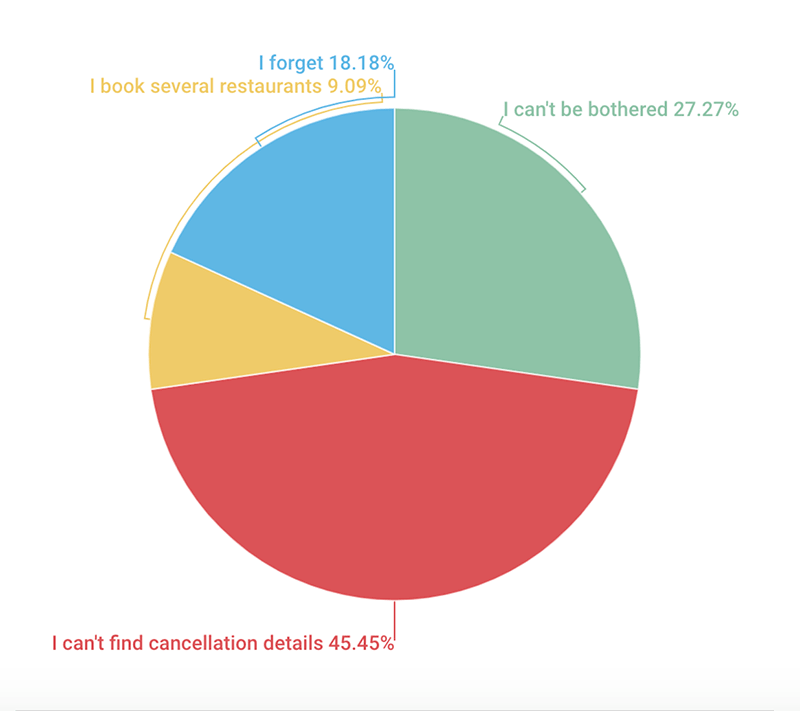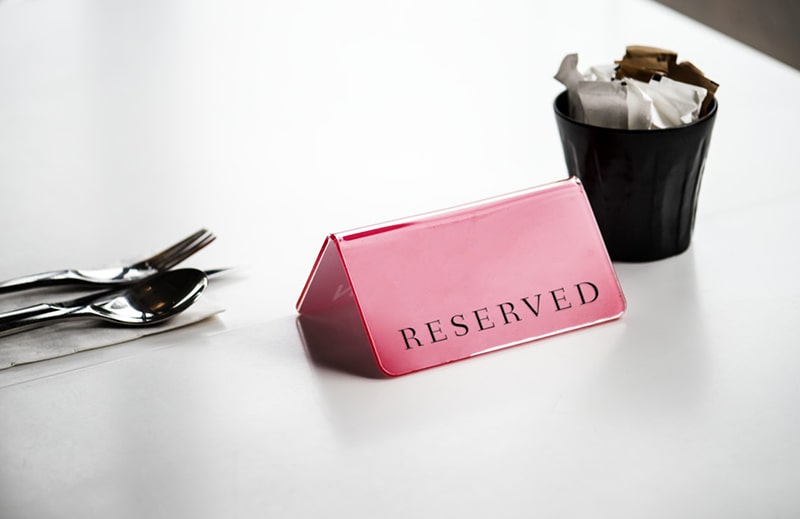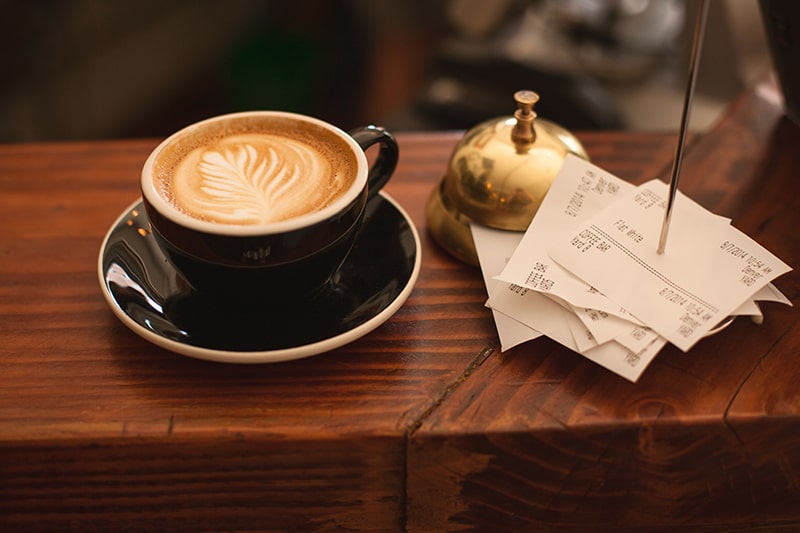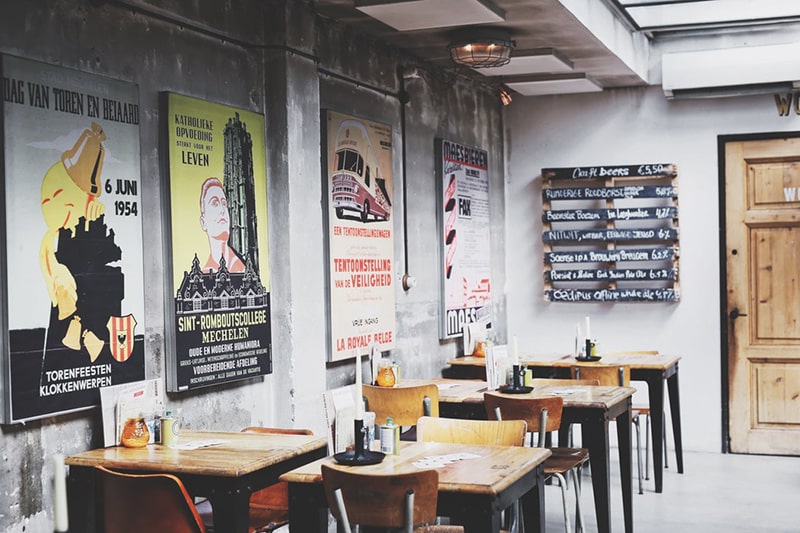Are you struggling to handle bookings for your restaurant, and failing to generate profit because a huge number of reservations that’ve been booked don’t turn up?
You’re not the only one, a number of experts have been sharing their thoughts on the subject.
Those missing customers, referred to as “no-shows”, can wreak havoc on your eatery--whether you’re a huge fancy restaurant in London or a country pub.
In this ultimate guide to restaurant no-shows, we’re breaking down the main reasons why diners don’t cancel their reservations--and enlisted the advice of six experts to help you handle them.
Read time: 13 minutes
What are No-Shows?
Why Don’t People Cancel Reservations?
1. Create (and Stick To) an Official Booking Policy
2. Consider Whether Reservations are Essential
3. Start Taking Deposits for Restaurant Bookings
4. Use Reservation Software That’s Easy for Diners to Use
5. Run a Waitlist for Queuing Diners to Take No-Show Tables
6. Provide A+ Customer Experience to Prevent Future No-Shows
Explain the Impact of No-Shows on Your Restaurant
Final Thoughts on Handling Restaurant No-Shows
What are No-Shows?
Before we dive into the details, let’s be crystal clear on what restaurant no-shows are.
No-shows happen when a customer makes a table reservation, but fails to turn up without notifying you beforehand.
It’s a huge problem in the hospitality industry because restaurants turn down reserved tables for diners who’ve arrived and want to eat.
You can’t offer a table to someone when its already been reserved, right? Yet it’s impossible to judge whether the party who’ve made the booking will turn up, so you’re stuck in a sticky situation--and end up losing profit if you keep your promised and reserve the table for a no-show.

Why Don’t People Cancel Reservations?
No-shows cost UK-based restaurants £16 million per year, and it’s estimated that 20% of diners fail to show up for their table reservations in big cities like London.
But why are people shying away from cancelling their reservations and resorting to a no-show?
We asked that question in an anonymous survey. Here’s what we found:
- 45% don’t cancel because it’s not easy to find cancellation information.
- 27% don’t cancel because they can’t be bothered.
- 18% don’t cancel because they forget they made the booking because the restaurant doesn’t send reminders.
- 9% don’t cancel because they book several restaurants and decide which they’ll attend nearer to the time.

6 Experts Share How to Handle Restaurant No-Shows
If no-shows form the bulk of your restaurant’s daily routine, don’t panic. You don’t need to get stuck in the cycle of accepting reservations from people with no intention of turning up, and ruin your chances of generating more profit from your diner.
It is possible to get a grip over the number of no-shows you’re dealing with.
In fact, we asked six hospitality experts to share how they handle (and prevent) no-shows in their own restaurants--and their answers might surprise you.
Ready? Let’s dive in.
1. Create (and Stick To) an Official Booking Policy
Chances are, you’ve got a range of policies that diners need to comply with in order to eat at your restaurant. But you might not realize you can create official booking policies that detail the terms and conditions of table reservations, including:
- How bookings should be made (e.g. through your website, a booking system or telephone).
- Whether reservations are necessary, or diners can walk in on the day.
- How far in advance a table reservation should be made.
Big name brands have official booking policies available to view on their website--like this example from Miller & Carter:

COSMO Restaurants also share details of their booking policy in Q&A-style on their website:

These official booking policies can be tailored to prevent no-shows, as explained by Arron Curtis, Head of Retail Operations at CRATE Brewery:
“Set out your bookings and cancellation policy,
and even take card authentications when taking bookings.
Explain that you may take a fee for failure to show,
or to not notify in the agreed time.”
Consider amending your table reservation policy to include what happens in the event of a no-show. Here are a few examples:
- How far in advance a cancellation is required.
- How long a table will be held for in the event of a no-show.
- Whether you’ll charge customers for not turning up if they haven’t cancelled their table reservation beforehand.
That could be as simple as adding this sentence to your policy: “We hold tables for 15 minutes, and if you fail to turn up within that time (without cancelling 24 hours beforehand), we’ll charge a fee of £10 to the card details entered during the time of booking.” M Gopalan Menon recommends informing guests with reservations that if they do not turn up on time, their table will be available to walk-in guests, to ensure diners understand the demand for tables at your restaurant.
The best thing about an official policy? It can’t be disputed.
Having a list of terms and conditions that people must agree to before making a reservation means they’re obliged to stick to them--allowing you more control over how you handle no-shows in your restaurant.
Attract more diners to your restaurant, with FREE restaurant marketing support from Carbon Free Dining:
2. Consider Whether Reservations are Essential

Creating a booking policy can take a huge amount of effort. Not only will you need to make it clear to customers that reservations need to be cancelled, but your restaurant staff will need to enforce it.
Sometimes, it’s effort you don’t need to waste.
If your restaurant isn’t jam-packed every day, consider ditching the need for a reservation. Allow diners to turn up on the day (if there’s a high chance of a table being available), and scrap the chances of leaving a reserved table open for a no-show.
Here’s Daniel Griffiths, Resort Operations Manager at Greenhouse Eco Resort, explaining why removing the need for a table reservation could help your restaurant get a grip over the number of no-shows you’re facing:
“If you’re a popular restaurant with a modern clientele,
then dropping the need to make a reservation during
peak times guarantees no no-shows!
It’s a brave move and many restaurants are afraid
they will lose guests - but offering reservations
at less busy times can redistribute your
peak times and reduce costly no-shows."
Daniel’s right.
Allowing walk-ins to form the entirety of your customer base is risky--people might not turn up in fear they’ll get turned away. But, only enforcing the need for an official reservation at peak times is a fantastic way to reduce no-shows.
Trevor Fox's advice is to make reservations on days when you know you will be full - for example on Christmas or Mother's Day, along with informing the guest that the table must have a 3-hour turn around in order to accommodate more reservations and diners. Furthermore, Belinda Barber suggests overbooking on key days, especially when you look at the statistics of how many people do not attend their reservation. However, by doing this, you also run the risk of your guests turning up and becoming annoyed if there is not a table ready for them, even though they made a reservation.
You can’t lose money on a no-show if they don’t have the option to book a table!
3. Start Taking Deposits for Restaurant Bookings
Feel unsure about taking deposits when customers want to book a table at your restaurant?
I don’t blame you.
Some customers can be put-off making a reservation if there’s a need to pay before they arrive (especially if they’ve booked a couple and are waiting to decide which they’ll visit nearer to the time), but 42% of restaurants in the UK are including prepaid deposits as part of their booking policy, it’s a surefire way to lower your no-show rate.
Consider charging customers a nonrefundable deposit that can be redeemed on the cost of their bill. That way, diners are more inclined to show-up for their reservation, and could spend more money because they’ve already got what seems like money off.
Martin Wilks, Hospitality Consultant and Stock Auditor, explains why he always takes a deposit for restaurant bookings:
“No restaurateur ever wants to alienate existing or potential customers
but it is fair to say that when a customer makes a table booking,
he is entering into an agreement to purchase those goods
as the sole beneficiary and is, therefore, excluding other customers
from that opportunity.
If the customer fails to complete their booking, it should not
be the restaurant or other displaced customers that suffer.”

He’s not alone, either.
Calanit Peretz, General Manager at Via Hostel, also takes nonrefundable deposits to prevent no-show. He advises:
“Take a non-refundable deposit on bookings. When taking a booking
for a large group, always take 50% deposit.”
But how much should you charge smaller tables to make a reservation? A 50% charge can sound a tad extreme.
Instead, calculate the amount you’d be happy to cover the cost of a no-show. It varies from restaurant to restaurant. For example: A posh London eatery might settle for £45, whereas a country pub might be happy with £10.
Whatever it is, make sure you’re taking that deposit before diners make a reservation.
Diners are much more likely to attend their booking if they’ve already paid cash towards it.
(Nobody likes losing money--that’s a fact.)

But what happens when customers aren’t able to make their reservation if there’s a genuine reason--like a family emergency, sickness or car breakdown?
Eric Weiss, President and CEO of Service Arts Inc, explains:
“Diners tend to be more likely to show if they are already invested
financially. If there is a no-show even with that, it is the owner or manager's
decision how they would like to follow up.
There could be a valid reason- sickness, emergency, etc.
In that case, the restaurateur may decide to credit
that deposit towards a future meal. If not, the deposit can be held.”

4. Use Reservation Software That’s Easy for Diners to Use
Managing reservations is tough. Not only do you have to keep track of who’s arriving and whether a table is ready for them, but many restaurant consultants recommend hiring a team of staff to work solely on managing reservations.
Don’t have the cash to spare on reservation staff?
Don’t panic--there’s software designed specifically for handling reservations.
Greg James Weiss, Hospitality Consultant and Private Chef, shares why an easy-to-use software is critical to reducing restaurant no-shows:
“I think starting with a good reservation software system is important.
One that is modern and congruent with people’s desire to respond,
or in this case lack of desire to cancel their reservation. Easy options
for texting back and forth to confirm and remind the customer
of their reservation.
A diligent host or hostess is important as well, he or she can call
the customer when they get to work after the automated reservation system
has sent messages to each reservation at specific and appropriate times
throughout the day of their reservation.”
Going back to our survey, 18% of people don’t cancel reservations because their either forget, or are unable to find cancellation information.
Solve that problem by finding a reservation system that sends automatic reminders with a cancellation link. That way, diners are reminded of their upcoming reservation, and cancel the table if they’re not planning on attending.
The same anonymous survey found some diners are more likely to cancel a reservation they’re not planning on attending if there’s an online system involved. In fact, one diner said:
“Usually I prefer to book reservations online, in which case
cancelling is fairly easy. I go out of my way to book places that
have an online reservation system.”
Online booking systems favour restaurant staff, too.
44% of reservations are taken during peak service hours when staff are potentially too busy to take the reservation--but if diners have the chance to book online, there’s no need to take time away from your restaurant staff when they’re busy serving customers.
So, which online booking systems can you use to handle no-shows?
Here are some suggestions:

Enhance your diner's experience at zero-cost with Carbon Free Dining!
Find out more:
5. Run a Waitlist for Queuing Diners to Take No-Show Tables
There’s nothing worse than holding a reserved table for a party you’re expecting, and turning down diners waiting for a seat--only for the party to never turn up. That leads to lost revenue, empty tables, and more importantly, unhappy customers you’re turning down.
That’s why we recommend running a waitlist for queuing diners.
Ask each diner who comes in asking for an immediate table for their name. Mention there’s a short wait to get a table, but you’re happy to put them on the list and let them know as soon as a space becomes available.
Martin Wilks explains:
“On a busy night, I would have a waitlist and have set dining periods
for each table booking so that it was possible to ensure at least one,
if not two, relays of each table so that the restaurant optimised
its occupancy and received the maximum possible revenue.”
Plus, if you advertise the fact you’ve got a waitlist, you can help to prevent the number of restaurant no-shows you’re dealing with. Here’s Paul Newman, Commercial Operations Specialist at FOODWELL, explaining:
“Always advertise with bookings that ‘your table may be given away
after you are 20 minutes late’, then tables can be offered up to waitlists.”
There are several tools you can use to manage a waitlist, such as:
- QLess
- Table’s Ready
- On Cue
- Harbortouch
- Waitlist Me
...but often, a pen and paper with names and waiting times will do the job!
Along with a waitlist, Laura Flannagan recommends only holding a reserved table for 30 minutes, to reduce wait times for potential customers.
Diners love posting about Carbon Free Dining Certified Restaurants on social media!
6. Provide A+ Customer Experience to Prevent Future No-Shows
Customer experience is important--that’s no secret. But did you realise that the experiences you’ve giving to your diners could impact the chances of a no-show?
It’s true: If you’re going above and beyond to impress your customer before their reservation date, they’ll feel appreciated.
Paul Newman shares how he embodies that idea with his restaurant guests:
“Customer engagement matters. If they think you care,
they will be loyal. Once they have booked say thanks, send a menu,
ask if they have any dietary issues, any specific area of the restaurant to sit.”
It goes without saying that providing an excellent service doesn’t stop there.
As soon as diners step foot in your restaurant, go above and beyond to help them. Be attentive, offer fantastic tasting food, and consider offering a loyalty card for customers to gain discounts if they come again.
You’ll soon build an army of raving fans who book reservations and actually turn up!

Explain the Impact of No-Shows on Your Restaurant
Do you suffer with a high no-show rate every night? Use your online booking system to track which bookings aren’t turning up, and keep a special note of those who repeatedly make bookings they don’t arrive for.
You could consider restricting these people from making reservations in the future, or send a quick email to explain the impact that no-shows have on your restaurant.
…”Would that work?”, I hear you ask.
The simple answer: Yes.
When we asked for the main reasons people do cancel their reservations, they said:
“It not fair that restaurants have empty seats because somebody
cannot be bothered to cancel. People maybe waiting and staff
maybe paid per table served.”
“Because it is rude not to and unfair on the business
who need to keep turning tables.”
“So the restaurant can reboot the table, and even more
because it means maybe someone trying to get a table won't miss out.”
“If I was having people over for a meal, I'd like to know before hand
if someone wasn't going to turn up. Restaurants deserve to know too,
especially if they're a small business where lost money makes a real difference.”
It just goes to show people do cancel reservations if they understand restaurant reservation etiquette, and recognise the impact it has on the business.
Why not explain the impact of your restaurant’s no-shows to the people who don’t turn up to theirs?
Here’s a quick email script you could send to no-shows:
“Hi, NAME! We’re so sorry you didn’t make your reservation at TIME today.
We understand there could be a variety of reasons you didn’t turn up,
but we’d greatly appreciate if you could notify us beforehand.
No-shows cost us a huge amount of potential revenue, and we could’ve opened
the table for another diner to help us keep everyone happy.
You can always cancel your booking by signing into your account on our website.
Thanks again for booking RESTAURANT, and we’d love for you to rearrange
your booking using this link. We hope to see you soon!”
That way, you’re politely explaining the value a no-show has on your restaurant, while inviting them to reschedule their booking (and not cutting ties).
Final Thoughts on Handling Restaurant No-Shows
As you can see, no-shows are one of the frustrations that many restaurants struggle with. You’re not alone in your quest to prevent them wreaking havoc with your revenue!
That doesn’t mean they have to plague your diner forever, though.
Remember to send several reminders for upcoming table reservations, use an online booking system that encourages people to cancel rather than abandon, and always deliver the best possible service to encourage loyalty.
Loyalty will make people book more reservations, and since they know you’ll deliver incredible food and service, there’s a lower risk of their table reservation progressing into a dreaded no-show.
Now, it’s up to you to test which of these techniques you’ll start using in your eatery. Whatever you find, we’d love to hear your results! And if you’ve got another tip for handling no-shows, drop it in the comments below.
The ultimate way to prevent restaurant no-shows is to create a diner experience that isn't found with your competitors...

.png?width=1571&height=766&name=CFD%20knife%20and%20fork%20logo%20(carbonfriendlydining.org).png)






